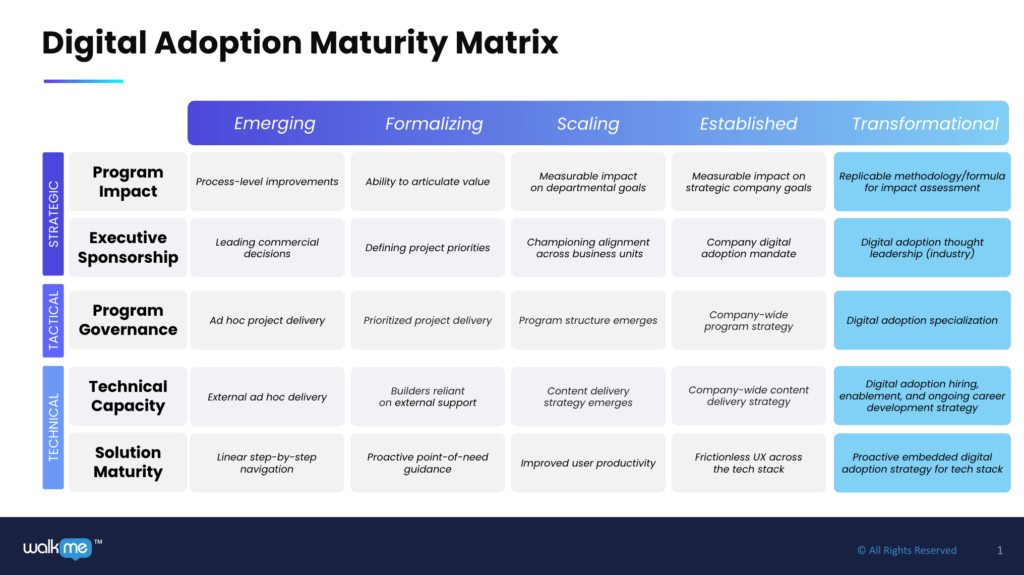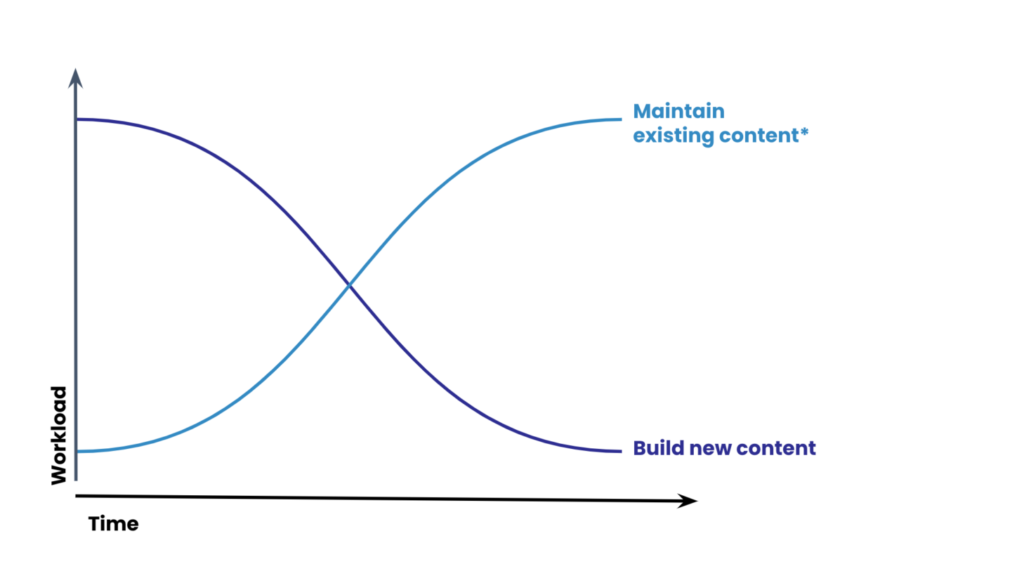A common question from my customers: How would you define a successful digital adoption program? To define success we also have to be aware of what factors could limit success. Here are the 7 potholes most commonly encountered – and avoided – by best-in-class digital adoption programs.
Avoid this #1: Treating WalkMe differently to other softwares
WalkMe is a disruptive product and requires a paradigm shift. However, at the end of the day, it’s a software – and just like any other software, it requires cross-functional collaboration, learning and development, subject matter expertise, a reporting and value strategy, and a change management strategy.
If you take the “WalkMe” out of it, the shape starts to look familiar. Your organization may not have created a digital adoption Center of Excellence before, but you’ve most likely created and scaled something cross-functionally in the past. And with it, you’ve likely had a strategy to consolidate knowledge in a knowledge base or shared communication platform.
The American Productivity & Quality Center (APQC) defines primary components to a Knowledge Management (KM) strategy as follows:
- Embed KM into the systems and processes where people do their work
- Build a network of champions
- Create a rewards and recognition program
- Strengthen relationships with partner functions
These sound pretty straightforward – because they are. Chances are, you have enablers already in place from your other Knowledge Management initiatives. You can leverage these for WalkMe. And in addition to the what (the knowledge management content) and the where (access point), consider the who: Which department led this initiative? How did they cultivate the cross-functional positioning and respect to make this successful?
Avoid this #2: Assuming you need a finished program before you can publish WalkMe in-app content
For anyone who has signed a limited or full enterprise licensing agreement for a software, you know: the (virtual) paper is barely off the signatory’s desk before there’s chewy, palpable pressure to justify the spend. Show me the value. Now.
With this comes the pressure of standardization. If we’re going to do it right, we have to do it right from the beginning. The Type A in me is twitching when I say this, but I’ll say it anyway. Not necessarily.
Consider the Digital Adoption Maturity Matrix, a leading framework to measure evolution of a digital adoption program (pictured). In its definition of stages Emerging through Established, those for Emerging have an undercurrent of ad-hoc. And quick-win, ad-hoc value…is still value.

Going live with a couple projects first is actually preferred. It helps you understand how WalkMe falls in your ecosystem, how difficult/easy it is to move through red tape, etc. Once you’ve published content on a couple platforms, use those wins to establish a strong framework and get it on the executive agenda. Don’t underestimate the power of starting from the bottom-up.
Avoid this #3: Thinking you have to go in alone
One of the most common (and most unwelcome) impacts of the Covid-19 economy on our operational strategies is the need for tighter budgets. And with a financially conservative, “suck-it-in” mentality, thinking about hiring additional headcount to specialize in digital adoption may feel a bit ridiculous.
Since Gartner created the Digital Adoption Platform category in 2019, digital adoption has become increasingly popular as a marketable skill. According to The State of Digital Adoption 2022, the number of individuals listing digital adoption as a Linkedin skill has increased 39% since 2021. Rather than playing tetris with your internal budget, why not leverage the market proficiency as a lower cost option?
One common example: Your company might already be partnered with a Global System Integrator for another digital initiative – chances are, that GSI might offer digital adoption services. Why not bypass the headache of onboarding another vendor and expand the purpose of your current partnership?
Start small, start contracted, and get your feet under you. Bonus: If you’re eventually hiring internally for your digital adoption program, you’ll have a much better handle on the ratio of headcount input to content output. Creating a business case for an internal hire just got that much easier.
Avoid this #4: Never saying “no” to a project
After 30 years in Sales, my dad decided to start a Willie Nelson Tribute Band as a retirement project. In year one, they took every gig that was offered to them – county fairs, dive bars, the works. In “leading with yes,” they grew their network and perfected their approach.
In year two, the band got more than double the inquiries and had to start saying “no.” What was their “brand” and which gigs aligned with that image? Which options were financially and geographically most desirable?
Your Digital Adoption Program is a dad band. Lead with yes, and know there will be a time where you can’t (and shouldn’t) give an immediate yes to everything. With the groundswell of knowledge comes a need to be selective so you can preserve your strategic alignment. If you’ve scaled to the point where you’re losing brand cohesion and people are suffering from burnout, you’ve gone too far.
As your program grows, the robustness of your intake process should grow as well. Don’t be afraid to put the onus on your Lines of Business to pitch you – Why should you play their gig? Make sure they put in the time to create a good business case, baseline metrics, etc. You’ll inevitably get some pushback, but remember – a program that says “no” is infinitely more respected than one that doesn’t. And the foundation of a successful program is, ultimately, respect.
Avoid this #5: Not incorporating maintenance into resource scoping
If building new content is the yin, maintenance is the yang. Building new content without maintenance ultimately lands you in one of the following scenarios, all contributing to a subpar end-user experience:
- Content breaks
- Content is strategically misaligned (all engagement, no impact)
- Workflows are oversaturated with visible in-app guidance
On the flip side, you don’t want your skilled builders to be spending all their time maintaining the status quo with no room for growth and innovation. To keep content fresh and reduce maintenance time, conduct regular health scans to reassess and remove outdated and irrelevant content. Less (high precision) content = less resources to build new content.

So, how long should I budget for maintenance? Similar to the point in Avoid This 3, be kind to yourself with forecasting in Year 1 of your digital adoption program. Just as you’re not going to know your exact headcount/output ratio from the get-go, you won’t know exactly how long WalkMe maintenance takes until it’s a part of your workflow. The sooner you start maintaining content and filtering those actuals back into your forecasting, the more accurate your forecasts will be.
How to start: The next project you scope, tack on a + 50% multiplier for maintenance over the next 2 quarters. Revisit at the 2-quarter mark and look at your delta. Wait! Require my employees to track their time? No thanks. If this brings up friction for you, do some discovery into how your product teams forecast and manage without time-tracking software (story points, anyone?).
Avoid this #6: Assuming you know the value story your executives want
We’ve all had a situation in the past where we thought we knew exactly what someone wanted…only to be dizzily disoriented in finding out we missed the mark.
Earlier in my WalkMe career, my champion and I were dually-presenting an executive business review to a newly appointed CIO. We had a beautiful presentation and air-tight engagement data. But as the meeting got underway, we knew something was off.
I then realized my mistake – though the prior CIO had taken WalkMe engagement data at face value, this new CIO had some aggressive KPIs for compliance risk reduction. Basic engagement numbers weren’t interesting to her. She wanted to pull up PowerBI dashboards and talk through the movement in data quality metrics in the last quarter (a leading success indicator for her KPIs) because the board was breathing down her neck.
The moral of this story: One size does not fit all when talking about WalkMe’s value. Leadership in your digital adoption program is leading with curiosity (and not only when new executives are hired).
How to start
Find 20m for a more informal meeting with your executive prior to your next WalkMe business review or status update. Similar to Avoid This 1, take WalkMe out of the picture for a minute. Reframe the leader not as the recipient of your message, but as a human with needs, fears, goals and preferences of their own.
What is this person’s style? What are their motivators? What are their most intense pressures and where/who are they coming from? What are they measured on? What “wins” would make them look like a hero?
Treat your executive like the individual they are. Confirm the language they want to speak and you can guarantee they’ll be engaged.
Avoid this #7: Set it & forget it
By now, you know optimizing your content is important (if not, see Avoid This 5). To be a best-in-class program, you have to be iterative with your process as well.
One of my customers has a “Program Retrospective” cadence for one hour, once a quarter. Two weeks prior to the meeting, they release an optional survey to their primary points of contact from the Lines of Business, asking for anonymous input using the Start, Stop, Continue framework. Each quarter, they publish “Program Release Notes” in their KB, citing specific feedback and noting changes they will incorporate to address said responses. Two examples from this most recent quarter:
- Feedback: We heard radio silence after submitting our intake form and weren’t sure when the CoE was going to get back to us.
- Response: Adding an SLA for a time expectation between Date of Intake Submission and Date of Project Approval
- Feedback (from multiple stakeholders): Translations elongated the time of the project and it took 2+ weeks longer than originally scoped
- Response: Adding a question to the Intake Form about a) Number of languages required for translations and b) Language priority
In conclusion
The most successful digital adoption programs draw from historical context, but don’t get caught up in it; they reflect on the past (see Avoid This 1), but aren’t bound by it.
In a complex business ecosystem, digital adoption should be a fresh breath of fluidity. Because of its uniqueness, it can simultaneously draw on institutional practice and find wiggle room to be nimble.
So stay nimble out there – and watch out for those potholes!

